
Product test
Apple iPad Pro 2021: tell me, what are you!?
by Dominik Bärlocher
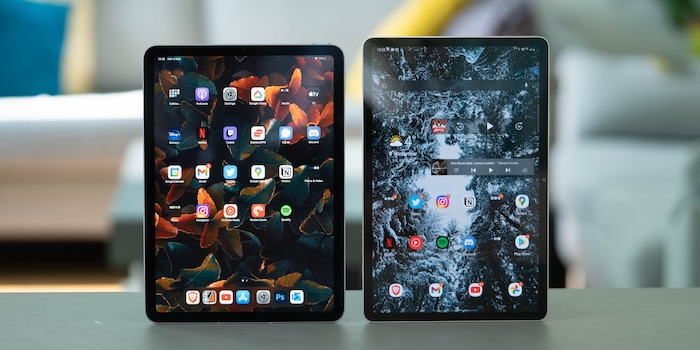
Even Android blogs write songs of praise for the iPad. Wow, how bad could Android tablets even be? Time for a detailed direct comparison.
Twitter: the Twitter app has slightly better features on the iPad. You have the menu on the left with messages, notifications, bookmarks, etc. On Android, you have to expand the menu and still have four icons at the bottom. Not a huge difference. In landscape mode, the iPad uses the right side for search and trends, while Android simply displays tweets in full. Not a particularly sensible use of space.
Instagram: now it's the other way around. There's no dedicated iPad app, only an inflated iPhone app that looks absolutely terrible. The tablet version for Android doesn't use the larger space cleverly either, but it looks worlds better than on the iPad.
Google Playbooks: I primarily read and buy my comics through Playbooks. Purchases aren't possible on the iPad, presumably because Google doesn't want to give Apple a percentage. On Android, you have black bars at the top and bottom when reading comics. On the iPad, they're to the left and right instead. The comic remains about the same size. Surprisingly, the iPad still gives you more elaborate animations when scrolling.
Comixology: on the iPad, Amazon's Comicapp is missing my library for some unknown reason. But as I hadn't used the app for a while anyway, I didn't bother looking for the reason. The Galaxy Tab makes slightly better use of space, and comics are larger than on the iPad.
Google Maps: Google Maps offers more options on Android, such as Explore Nearby, showing menus right at the bottom of the screen and filter options below the search bar. However, these options are also available on my buddy's iPad Pro. Thus, this isn't necessarily due to the operating system.
Outlook: Microsoft's app looks better on Android in landscape mode. Next to the inbox and opened mails, the folder structure still has enough room to breathe. On the iPad it unfolds, covering the inbox.
Netflix: like all other video apps, Netflix looks better on the Galaxy Tab. You see more content and have fewer black bars due to the 16:10 aspect ratio.
Twitch: the Twitch app automatically switches from landscape to portrait mode on the Galaxy Tab (happens on my Pixel 5 as well) when I click «Browse». The app works correctly for the other three menu items. Apart from this peculiarity, both apps are identical.
Signal: the up-and-coming chat app has a dedicated port for the iPad that can be used in parallel with the smartphone version. The Android tablet and smartphone versions are identical, which is why only one can be active at a time. But as I don't feel like constantly activating the corresponding device, this version is practically useless for me.
Microsoft Word: the iPad automatically takes over my existing account from the Outlook app and I can get started right away. On the Galaxy Tab, the two apps don't communicate, so I have to log in separately before I can even open a document. Otherwise, the form factor of the iPad is also an advantage here. You have more menu items to choose from directly. However, if you work with an attached keyboard in landscape mode, this advantage is nullified.
Google Docs: once again, we see the complete opposite to Word. The Galaxy Tab logs you in directly as the whole system is Google-based. Apple knows my Google account, but first asks if I want to log in with it. Otherwise, the app versions don't differ from each other.
Discord: When you click on a chat on Android, the chat opens in full screen. On the iPad, you'll still see the three menu tabs for Servers, Server Content, and the selected chat window. In portrait mode, both apps behave the same.
I tested several other apps such as Notion, Republic, Pocketcasts, YouTube Music or Spotify, but couldn't notice any differences there.
Unfortunately, Google's system doesn't offer a preinstalled free alternative to the popular video-editing program iMovie. Apple's app is intuitive and offers numerous options for editing short or even longer movies. With Android, you are spoiled for choice. Adobe Premiere Rush would have been a promising candidate. Unfortunately, the app is available for iPads and Android smartphones, but not for tablets. I therefore decided to use ActionDirector.
Photoshop: while Android users only have access to the slimmed-down Express version, full-fledged Photoshop is available for the iPad. If you've used an Adobe app on iPad before, the app logs in directly. On Android, you get to type everything in again first. Photoshop for iPad is clearly better, but it costs more than Express. Which is in turn perfectly adequate for everyone except professionals.
Anyone looking to use their tablet for more than the occasional game or YouTube video will require multitasking functionality. A central tool here is the app overview. It's clearer on the iPad and provides more information thanks to the wider display. The Galaxy Tab doesn't even manage to align all apps correctly in this view. If you first use the app overview in landscape and then in portrait mode, some apps don't rotate.
If you switch between apps often or use several at once, it's beneficial to be able to pick up where you left off. Unfortunately, the Galaxy Tab kills background apps very quickly. On the iPad, I can usually even open an app the next day and still be in the exact same place.
The first thing you notice is that the Galaxy Tab stylus is shorter, thinner and lighter than the Apple Pencil. It also feels a bit cheaper and worse to hold. However, it won't cost you extra as it's included in the delivery. You'll have to pay around 130 francs for the Apple Pencil, but you also get a high-quality pen that feels great. Both pens are charged contactlessly by attaching them to the tablet. They are naturally magnetised.
To compare the accuracy of both pens, I drew a few sketches in Autodesk Sketchbook using my Picasso-like painting skills. For non-designers such as me, there's no difference. On both devices, the pens react extremely directly, precisely and sensitively to different pressures.
The Chinese open-world RPG «Genshin Impact» is the ideal test candidate to really push the devices to the limit. With all graphics details set to maximum and 60 fps, the Galaxy Tab regularly experiences stutters during fast movements or when fighting. The iPad, on the other hand, masters even bigger battles without problems.
In most other games, such as Fortnite or Call of Duty Mobile, it doesn't matter on which device you play. Only very few mobile games really exploit tablets. One advantage of the Galaxy Tab is once again the 120 Hz display. Thanks to this, you can play games that support 120 fps much more smoothly. An advantage that shouldn't be underestimated by frequent gamers.
Samsung takes the lead in terms of the display. Not only do the colours look more vivid, the highlight is the 120 Hz refresh rate. This makes every swipe and scroll feel much smoother than on the iPad. Once you've seen a direct comparison, you can't unsee the jerky 60 Hz. Apple also offers 120 Hz displays, but only in the more expensive iPad Pro.
Despite the poorer display, animations often look smoother on the iPad. On the one hand, the designers have probably created smoother animations, on the other hand, it regularly falters on the S7.
A few more words about the battery. Here, my suspicions aren't quite confirmed. The iPad is undoubtedly enduring. I can leave it lying around for days, even weeks, and it still has juice. The Galaxy Tab doesn't quite come close to the iPad's standby time. However, when I use the devices heavily for a while, the Galaxy Tab holds out for longer.
Otherwise, both are metallic rectangles with rounded edges and little design differentiation.
As an Android user, the iPad isn't particularly intuitive, and I often feel limited in my options. And the fact that I've already pretty much exhausted the paltry 5 GB of iCloud storage for backups during testing is just ridiculous. Apple then forcing a subscription on me is just more salt in the wound. Just like the AppleCare ad, prominently placed in the settings. Unacceptable from a device in this price range.
I must admit, I expected a clearer verdict. Even I, as an Android user, grew to suspect over the years that iPads are actually secretly better than Android tablets. However, my direct comparison over several weeks has now shown that things are a bit more complicated.
Both manufacturers don't show any weakness when it comes to pen usage. The Galaxy Pen is a bit more versatile thanks to countless gestures, functions and shortcuts. The Apple Pencil, on the other hand, might have a hit on its hands with «Doodle», but it still needs some fine-tuning.
As a child, I wasn't allowed to have any consoles. It was only with the arrival of the family's 486 PC that the magical world of gaming opened up to me. Today, I'm overcompensating accordingly. Only a lack of time and money prevents me from trying out every game there is and decorating my shelf with rare retro consoles.
The iPad is one of those products that no one asked for, yet everyone wanted. Although Apple's tablet is losing market share worldwide when compared to Android tablets, it's still the most popular. As also confirmed by my subjective opinion. Even friends with Android smartphones often own an iPad. Tech blogs usually agree that the iPad is by far the best tablet anyway, and that Android alternatives come directly from hell. Yet until a year ago, I exclusively used these infernal instruments. There was little to complain about, aside from performance.
Whether it has to do with prejudice, Apple's marketing or an actual lack of decent Android tablets, time to discover the truth. I also based my test on input from the digitec community that responded to our Instagram post. Especially multitasking, pen input and video editing were in focus there. For the comparison, I use an iPad Air (2020) and a Galaxy Tab S7. The latter is considered one of the best Android tablets and comes closest to the iPad Air in terms of price, performance and size. Due to cost reasons, I cannot determine which is better suited as a cutting board – that much up front. Sorry Instagram user kanibanani ;).
What used to be the case with Android smartphones still happens from time to time with its tablets. Namely, apps that exclusively offer one iOS version. GarageBand, iMovie, Clubhouse, Procreate or any games that are exclusive to Apple Arcade. As tablets aren't as popular as smartphones, not every developer makes an effort to programme a corresponding port. I'm personally not missing out on any tablet app, aside from a few games. However, there are definitely differences in quality – on both sides.


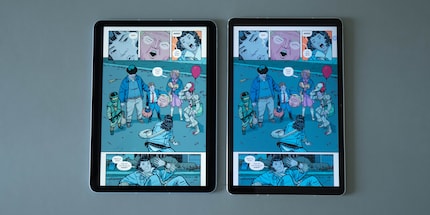


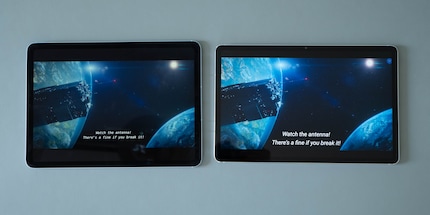
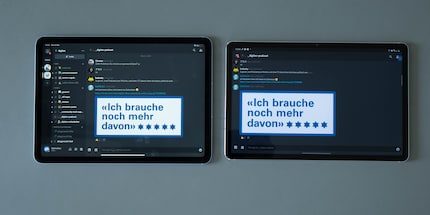
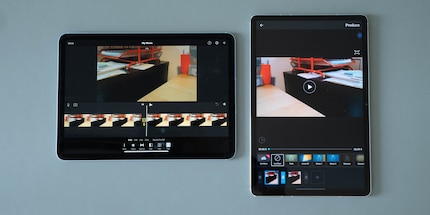
ActionDirector: unlike iMovie, ActionDirector costs a few francs per month depending on the subscription, but provides more editing and export options. The handling isn't quite as elegant, and on the tablet it only works in portrait mode, which really doesn't make sense for larger projects. All in all, however, you can edit your movies quickly and easily on both devices. Rendering a six-minute video with a few effects in 1080p resolution takes about the same amount of time on both devices. ActionDirector also offers UHD, which iMovie does not.
Both programs are also available for PC and Mac. So you can continue your projects there as well.
Lightroom: on the iPad, I first downloaded the wrong app, which then told me to please download the iPad version. This gave me nasty flashbacks to the PS5/PS4 mix-up. After that, however, the Android and iPad versions are identical, with the usual difference that you have significantly more space to work with on the iPad in landscape mode. Navigation is also a bit more cumbersome on Android. For one thing, the menus are more convoluted, and for another, you can't navigate freely through them, but must first cancel each selection before you can move on to the next.

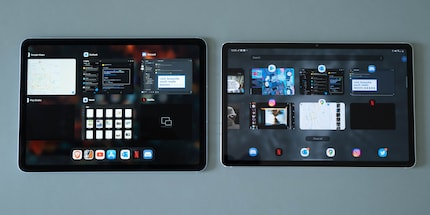
Both devices offer split screen, something Samsung pioneered. On the iPad, you'll need to drag two apps from the app bar to the edge of the screen. To achieve the same effect on Android, simply hold down the app icon in the app overview and then select Splitscreen. I don't find either option particularly intuitive. However, while you can replace one split screen app with another through the same process on the iPad, I haven't been able to do this on the Galaxy Tab (it works fine on my Pixel). Two bundled apps can only be removed together. After that, the only way to combine two new apps is to start the split screen process all over again.
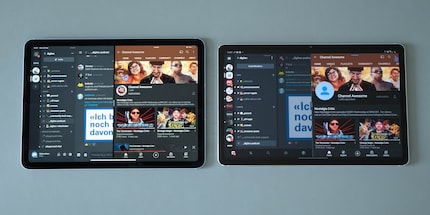

The Galaxy Pen has a small button that you can assign with various commands such as launching the camera app. It also allows gestures by pressing the key and simultaneously waving it like a magic wand. Once again, you can assign gestures to different apps. However, apart from Microsoft Office and Chrome, no third party app I have installed supports this feature. Besides, the button is so small that I always have to align the stylus first to be able to press it. With the Apple Pencil, you can choose between three options by tapping the flat side. For example, switching between tool and eraser rubber.
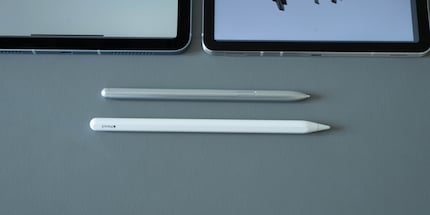
Samsung has implemented the stylus extensively in its system thanks to a freely placeable quick selection menu. What is missing, however, is an alternative to «doodling». On the iPad, this feature lets you write with the stylus in virtually any app that has a text field. The notes are then automatically converted into text. Extremely useful, although not 100 per cent accurate and officially only supported in English. However, German works relatively reliably. On the Galaxy Tab, the pen only works in compatible apps, of which there are fortunately many.

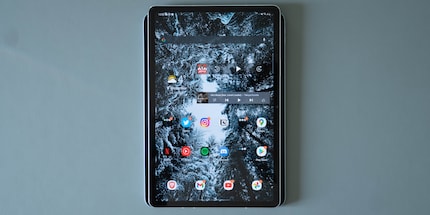
The Galaxy Tab S7 only serves as a representative for Android tablets. Nevertheless, I'll briefly go into the hardware. The main difference concerns the form factor. Most Android tablets are in 16:10, while the iPad relies on 4:3. 4:3 was used on old tube TVs and the first flat-screen TVs. Every modern TV set has 16:9. Apple's decision was ridiculed at first, but once again, Cupertino has shown a good hand. For everything except watching videos, 4:3 is undoubtedly the better choice. The device feels better to hold and apps can utilise the screen area better.

During my multiple weeks of testing, I noticed a few smaller and bigger things that don't fit into any category. For example, you could always use an alternative keyboard app such as Gboard on the iPad. The thing is, whenever you have to log in anywhere, the Apple keyboard annoyingly pops up without fail. A royal pain in the neck, as both interfaces are controlled completely differently. This lack of personal input occurs in other areas as well. You can't even install free apps without a security check. The fingerprint scanner on the power button responds quickly. However, I often press down too hard, immediately turning the iPad off. Aargh! And Face Unlock is not available for the iPad Air. Face recognition is supported by the Galaxy Tab, but it's so unreliable that I hardly ever use it.
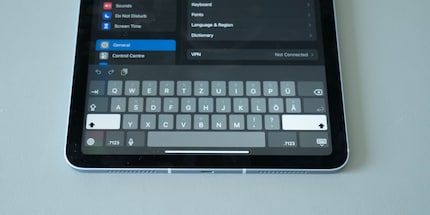
Samsung's tablet also comes with the typical Samsung problems. Even though One UI, which is applied over Google's Android, has been slimmed down considerably and is also somewhat presentable, it still feels cluttered. It's too convoluted for me. Samsung also imposes its apps and services on you everywhere. Some applications also have to be purchased or updated via the Galaxy Store. This just isn't user-friendly. It reminds me of cheap Chinese phones – pop-up ads included! The system just doesn't appear like one (hehe) cohesive unit. Which, to be honest, it really isn't.

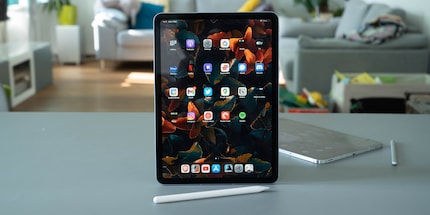
A few notions have been confirmed. The iPad feels faster and smoother overall. This despite the fact that the Galaxy Tab undoubtedly has the smoother display thanks to 120 Hz technology. Samsung gives Apple the cold shower when scrolling or browsing. However, as there are hardly any jerks on the iPad and animations appear smoother, it still feels better to handle. Even more annoyingly, the Galaxy Tab has worse RAM. I constantly have to restart a previously opened app just because I used another app for a bit. That almost never happens on the iPad.

What about the apps? In the applications I tested, differences were relatively small. On the iPad, space is often better used and you have a bit more information on display, but it doesn't make a decisive difference. What bothers me more is that Instagram only runs as a bloated iPhone app on the iPad, which is absolutely unappealing. Android does have some gaps when it comes to certain apps, but there are practically always equivalent alternatives. And anyone looking to watch a lot of videos will be better served with 16:10 Android devices. Otherwise, Apple's 4:3 format wins out every time. It feels much better to hold. The Galaxy Tab feels too tall in portrait mode and too wide in landscape mode.
All in all, I easily prefer the iPad. This is thanks to the hardware, which looks more convincing despite the 60 Hz display. Or the apps that are often a bit better or more unique on the iPad. Primarily, however, it's because the iPad emerges from a single mold. I know this is old news, but I don't need a second app store on my tablet and an additional Samsung app for every bit of nonsense. The iPad actually appeals to me more. The only thing that could change my mind is Google. I'll have to come out as a Pixel fan once again. If Google were to deliver a successor to the top-notch Pixel C that combines sleek design and a 3:2 form factor with the untouched Android, I wouldn't hesitate for a second. As of now, however, the best tablet for me is the iPad.

Siemens EQ700 integral TQ717D03